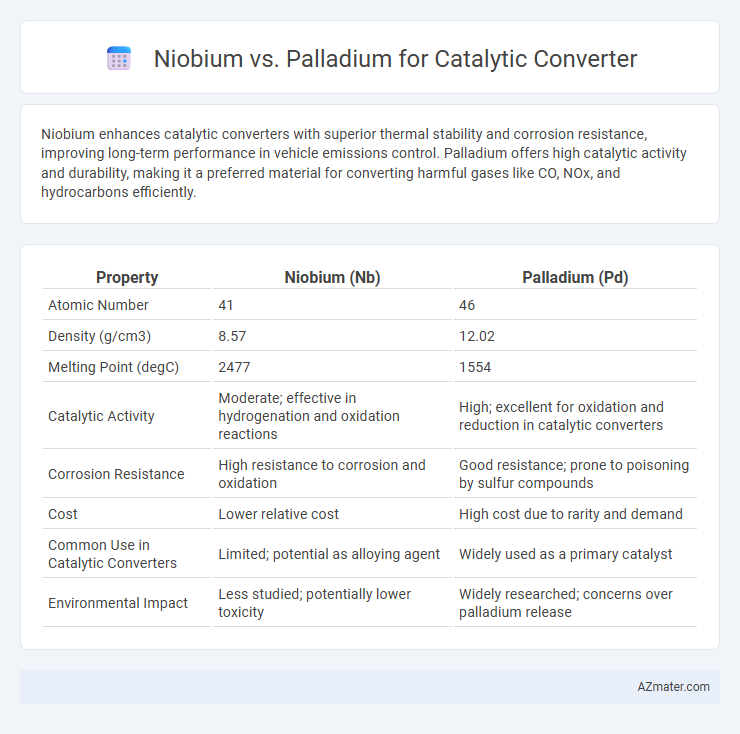Niobium enhances catalytic converters with superior thermal stability and corrosion resistance, improving long-term performance in vehicle emissions control. Palladium offers high catalytic activity and durability, making it a preferred material for converting harmful gases like CO, NOx, and hydrocarbons efficiently.
Table of Comparison
| Property | Niobium (Nb) | Palladium (Pd) |
|---|---|---|
| Atomic Number | 41 | 46 |
| Density (g/cm3) | 8.57 | 12.02 |
| Melting Point (degC) | 2477 | 1554 |
| Catalytic Activity | Moderate; effective in hydrogenation and oxidation reactions | High; excellent for oxidation and reduction in catalytic converters |
| Corrosion Resistance | High resistance to corrosion and oxidation | Good resistance; prone to poisoning by sulfur compounds |
| Cost | Lower relative cost | High cost due to rarity and demand |
| Common Use in Catalytic Converters | Limited; potential as alloying agent | Widely used as a primary catalyst |
| Environmental Impact | Less studied; potentially lower toxicity | Widely researched; concerns over palladium release |
Introduction to Catalytic Converter Materials
Niobium and palladium are critical materials used in catalytic converters, each offering unique catalytic properties for emissions control. Palladium is widely favored due to its excellent oxidation and reduction capabilities for converting harmful gases like carbon monoxide and hydrocarbons into less toxic substances. Niobium, though less common, enhances thermal stability and durability, making it a valuable additive in advanced catalytic converter formulations.
Overview of Niobium and Palladium
Niobium, a transition metal known for its corrosion resistance and high melting point, is increasingly explored as a cost-effective alternative to palladium in catalytic converters. Palladium, a precious metal from the platinum group, dominates catalytic converter use due to its exceptional ability to facilitate oxidation and reduction reactions, efficiently converting harmful gases into less toxic emissions. While palladium offers superior catalytic performance, niobium's abundance and stability under extreme conditions make it a promising candidate for sustainable automotive emissions control.
Chemical Properties Relevant to Catalysis
Niobium exhibits high thermal stability and strong resistance to oxidation, making it effective in catalytic converters exposed to extreme temperatures. Palladium possesses excellent hydrogen absorption and oxidation-reduction properties, crucial for converting harmful gases like carbon monoxide and hydrocarbons into less toxic substances. The differing electron configurations of niobium (4d^4 5s^1) and palladium (4d^10) influence their catalytic behaviors, with palladium generally offering superior catalytic activity in automotive emission control.
Catalytic Efficiency: Niobium vs Palladium
Niobium demonstrates promising catalytic efficiency in converters due to its strong oxygen storage capacity and resistance to thermal degradation, enhancing long-term performance. Palladium remains widely used for its superior ability to catalyze oxidation reactions and reduce harmful emissions effectively at lower temperatures. Comparing both, niobium offers increased durability and thermal stability, while palladium provides more immediate catalytic activity, impacting overall catalytic converter efficiency.
Durability and Longevity in Converter Applications
Niobium offers superior thermal stability and resistance to oxidation, contributing to enhanced durability in catalytic converters exposed to high exhaust temperatures. Palladium demonstrates excellent catalytic activity but tends to degrade faster under prolonged thermal cycling and harsh conditions. Niobium's ability to maintain structural integrity over extended periods ensures longer service life and reduced frequency of converter replacements compared to palladium-based options.
Cost Comparison and Market Availability
Niobium offers a cost-effective alternative to palladium in catalytic converters, as its price per kilogram is significantly lower, with niobium averaging around $40/kg compared to palladium's fluctuating cost exceeding $2,000/kg. Market availability of niobium is more stable due to abundant reserves primarily in Brazil and Canada, whereas palladium faces supply constraints linked to limited sources in Russia and South Africa, driving price volatility. The economic advantage of niobium, combined with its sufficient catalytic properties, is encouraging automotive manufacturers to explore its integration for reducing overall production costs.
Environmental Impact of Niobium and Palladium
Niobium offers a lower environmental footprint compared to palladium due to its greater abundance and less energy-intensive extraction processes, resulting in reduced greenhouse gas emissions during production. Palladium mining and refining contribute significantly to environmental degradation, including soil and water contamination from toxic chemicals used in extraction. Incorporating niobium in catalytic converters can enhance sustainability by minimizing resource depletion and decreasing harmful environmental pollutants associated with palladium dependence.
Performance in Emission Reduction
Niobium enhances catalytic converter performance by improving thermal stability and resistance to sintering, leading to more efficient emission reduction under high-temperature conditions. Palladium offers superior oxidation capabilities, effectively converting hydrocarbons and carbon monoxide into less harmful gases, which significantly lowers tailpipe emissions. Combining niobium's structural benefits with palladium's catalytic properties results in prolonged catalyst lifespan and optimized reduction of nitrogen oxides (NOx), hydrocarbons (HC), and carbon monoxide (CO).
Industrial Adoption and Trends
Niobium's use in catalytic converters is gaining traction due to its corrosion resistance and cost-effectiveness compared to palladium, which remains the industry standard owing to its superior catalytic activity and established supply chain. Growing industrial trends indicate increased research into niobium-enhanced catalysts to reduce dependence on expensive palladium amid fluctuating market prices. Automotive manufacturers are gradually incorporating niobium composites to improve durability while maintaining emission standards, signaling a shift towards alternative catalyst materials in response to global demand and regulatory pressures.
Future Prospects in Catalytic Converter Technology
Niobium offers promising future prospects in catalytic converter technology due to its excellent thermal stability and oxidation resistance, which can enhance catalyst durability and reduce precious metal usage. Palladium remains a critical component for its high catalytic efficiency in reducing harmful emissions, but its scarcity and rising cost drive the search for alternatives like niobium alloys. Innovations in niobium-based catalyst supports and composites may lead to more cost-effective, sustainable catalytic converters with improved performance and longevity in automotive emission control.

Infographic: Niobium vs Palladium for Catalytic Converter
 azmater.com
azmater.com